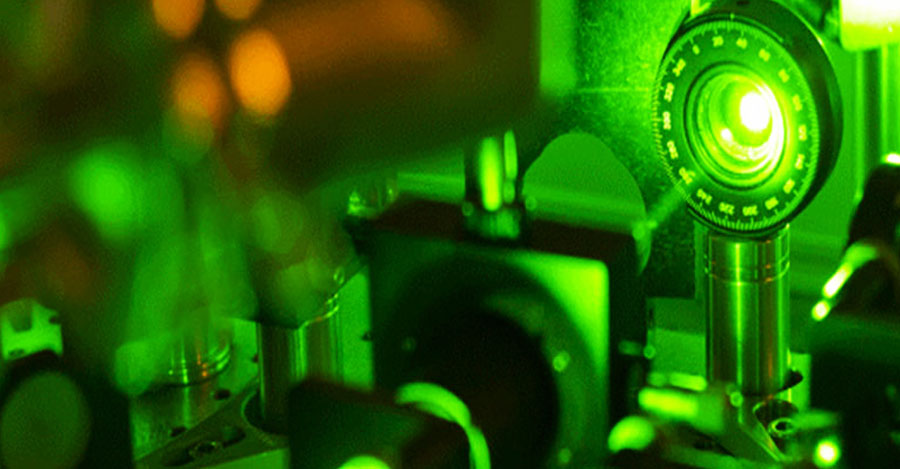
Have you ever wondered why our cell-phones or laptops always overheat when we use it too often? In our daily activities, we see how our electronics are limited by the speed of data processing. Our computers, new smart technology, and many other electronics need to handle copious amounts of information while still remaining efficient for our daily needs. With more information being shared and processed every day, we know that we need to improve these functions. Now, research is showing us how we can harness the power of light over electricity using photonics and change the world around us as we move into the future.
The research of photonics started in the late 1960s. Photonics has a root word “Phos,” which in Greek stands for “Light.” Photonics is “particles of light,” which in essence is what the practice is centered upon – technology using light. The field delved into research when the laser was created, and after that, stemmed new technologies that revolutionized the 20th century.
Bandwidth (aka linewidth) of a wavelength, has a limited range and is one crucial role photonics plays a part of. With fiber optics and photonics, bandwidth is limitless. Not only can our internet speeds travel at the speed of light, our technology will stop heating up due to overuse and our service will not be limited to our locations.
The role of photonics in our lives
Our SUNY Polytechnic Institute is a leader in the field of integrated photonics. They are pioneering the Department of Defense-led American Institute of Manufacturing Integrated Photonics (AIM Photonics).
“AIM Photonics was created as an industry-driven public-private partnership, with members and partners from across New York State and the nation ranging from industry, academia, and government,” said Dr. Michael Liehr, AIM Photonics CEO. “This world-class initiative focuses the nation’s premiere capabilities and expertise to lead the world in manufacturing this critical technology, which plays a significant role in national security applications. At the same time, this effort strives to strengthen the U.S. economy by building a robust ecosystem for the development and manufacture of integrated photonics.”
With photonics being so important, but also complex and new to our everyday research, there are many questions to ask.
The first thing we need to know is what exactly is integrated photonics? One of our resident experts, Dr. Robert Geer, Professor of Nanoscale Science at SUNY Polytechnic Institute, is able to explain. He tells us that “photonics refers to technologies (i.e. materials, devices, and systems) that utilize photons (particles of light) to send, receive, and process information similar to how modern-day electronics send, receive, and process information using electrons (e.g. electric currents).”
That explains the basics of Photonics. But to know how this technology can be implemented into our daily lives, we need to understand the difference between electric currents and light signals in transmitting and processing data. Integrated electronic devices (such as transistors, integrated circuits, computer chips) communicate through electric currents. But electric currents must overcome resistance. It is resistance which causes electrical circuits to heat up and to consume battery power, like in the case of mobile devices.
Electrical signals have limited speed, and sometimes the speed of a computer chip or integrated circuit is limited by the design and materials used in the circuit. On the other hand, photons can propagate in certain materials with virtually no loss (which is why we use fiber optic cables to transmit information over very long distances). In addition, photons travel at the speed of light and don’t face the speed limits of our electrical signals. The advantages of photonics can be huge.
What is photonics contributing to?
One of the largest applications for integrated photonics right now involves high-performance computing. The most common examples of this would be a data server farm like those provided by Google or Amazon. Integrated photonic devices are used to transmit massive amounts of data between high-performance computers to reduce the power loss and signal delays that exist with conventional electronic interconnect between chips and servers. Using integrated photonics we can increase the efficiency of high-performance computing to save energy and money, as well as keep data throughput as high as possible. With the demand for data processing growing by the day, this is incredibly important to data centers and cloud computing.
Besides computers, how else can integrated photonics be expected to impact our future? It is seen as a new wave of technology that is not just applicable to one usage. As Dr. Geer says, “Integrated photonics (i.e. photonic ‘chips’ which combine photonic signal transmission, processing, and, possible conversion to/from an electrical signal) allows us to directly process and control optical signals similar to how integrated circuits have allowed us to manipulate electronic signals. This is incredibly important for complex optical sensors – think the optical sensors on self-driving cars and other autonomous vehicles that allow the control electronics to ‘see.’ We need integrated photonics to be able to handle the massive amount of visual data that a complex optical sensor would collect (similar to your eyes).
“Also, integrated photonics will be crucial to create ultra-small biosensors used for medical device applications – both for diagnostic testing and perhaps even for implantable medical devices. This is very important since light can often be used to interface with biological cells or tissues without harm.”
SUNY’s role in photonics
With the potential uses for integrated photonics, someone needs to be behind the research and development of these applications. That’s where SUNY Polytechnic Institute plays a role.
SUNY Poly’s silicon fabrication facility is leading the way to develop an integrated photonics infrastructure so that devices and systems can be manufactured with the same ease and flexibility as modern integrated circuits and computer chips are manufactured. And students are involved every step of the way. From new photonic device designs, to integrated photonics device testing and chip fabrication, students are able to work alongside professional photonics engineers and designers.
As SUNY Poly spearheads AIM Photonics, with nodes in Albany and Rochester, it is advancing integrated photonic circuit manufacturing technology development while simultaneously providing access to state-of-the-art fabrication, packaging, and testing capabilities for small-to-medium enterprises, academia, and the government.
But it’s not only at SUNY Poly where these opportunities are taking place. The concepts and technologies for integrated photonics are also being introduced to students at other SUNY campuses – including SUNY community colleges – to familiarize them with the concepts of integrated photonics and educate them about future career paths in these fields.
For example, the AIM Photonics initiative is working to reduce energy consumption in data centers by supporting the replacement of traditional copper wires with optical fiber; providing technology for optics in next generation (5G) wireless networks; helping develop the optical equivalent of radar (lidar) which will facilitate the use of self-driving vehicles; and in partnership with the University of Rochester, the initiative is developing emerging optical sensors for medical and environmental applications.
Our SUNY Chancellor Kristina M. Johnson has a number of patents centered around light-technology. She is working with SUNY Poly where she believes that their two campus framework will drive further success into the future of photonics and all technology alike. In blending these emerging discipline, like photonics, nano-science, and nano-engineering, SUNY can truly help pave a path for innovative technologies to improve business and life in New York State.
Now that we have gained a general knowledge of integrated photonics, we can look forward to seeing beneficial changes and developments that affect our daily lives in the years to come.




Genius, this can be efficient
Thanks for this article and the research you are performing to help reduce energy consumption. Best of luck on your future discoveries and efforts!